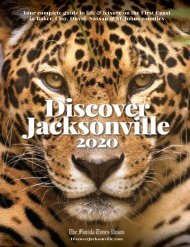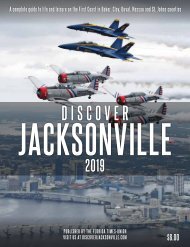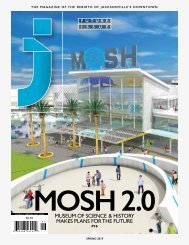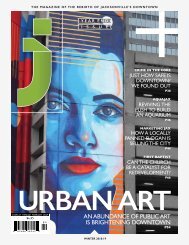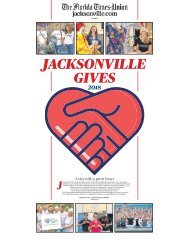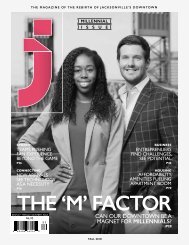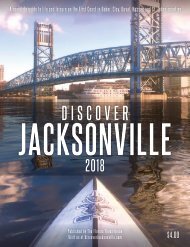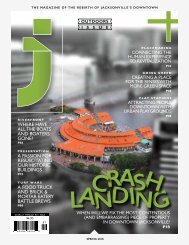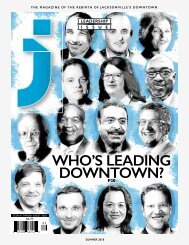J Magazine Winter 2019
You also want an ePaper? Increase the reach of your titles
YUMPU automatically turns print PDFs into web optimized ePapers that Google loves.
“Someone came up with the theme that LaVilla is a<br />
diamond in the rough waiting to be reborn again.<br />
We latched onto that, making it even more<br />
pronounced in the final design.”<br />
Andrew Rodgers director of Construction and Engineering<br />
Transportation Center ranged from $130 million to $150 million. No<br />
wonder it never got off the ground.<br />
Ford decided to make the Regional Transportation Center look<br />
forward, not backward. And he set a goal of reducing the cost.<br />
So he invited firms to compete for a modernistic design that would<br />
dramatically reduce the cost. The POND firm and Michael Baker International<br />
won the competition.<br />
The result: A $59 million bottom line, not $130 million.<br />
Cutting out a parking garage reduced the cost. Otherwise, the more<br />
modernistic design allowed for more efficiencies.<br />
Besides the lower cost, JTA wanted a design that makes a statement<br />
on innovation. The new building, with the Skyway running through it,<br />
is reminiscent of Walt Disney World.<br />
“We wanted something forward-thinking that would stand the test<br />
of time, that futuristic look,” said Andrew Rodgers, director of Construction<br />
and Engineering, Construction and Capital Programs.<br />
The shapes on the glass on the building have a dramatic effect,<br />
with blues turning color as the light changes. The shapes of the glass<br />
look like diamonds.<br />
“Someone came up with the theme that LaVilla is a diamond in<br />
the rough waiting to be reborn again,” Rodgers said. “We latched onto<br />
that, making it even more pronounced in the final design.”<br />
The design is focused on the customer, it emphasizes safety and<br />
convenience. While it is a new home for JTA employees, too, customers<br />
are the first priority.<br />
Compare it to the current Rosa Parks hub where someone going to<br />
a bus must cross multiple lanes of bus traffic. At the Regional Transportation<br />
Center, there will be one loading platform for all of the buses.<br />
“It’s a lot safer and more effective,” Rodgers said.<br />
The Regional Transportation Center also will have a pedestrian<br />
bridge over Forsyth Street that connects to the inner-city bus terminal<br />
(Greyhound). Pedestrians won’t have to cross Forsyth Street and cars<br />
zooming down the Interstate ramp.<br />
Of course, there is heightened security. JTA enlisted consultants as<br />
well as advice from the federal Transportation Security Administration.<br />
A $500,000 partnership with Cisco will result in cameras everywhere.<br />
That means a suspicious person or package can be identified<br />
and followed throughout the terminal.<br />
The customer focus will include a plaza where food trucks or other<br />
activities can be held. The LaVilla Room will be open for public events.<br />
There will be some retail space on the ground floor, possibly space<br />
for grab-and-go food items.<br />
And the board room on the top floor will have over twice the space<br />
than the current board room. Community events could be held there<br />
as well since, of course, it will be just about the most convenient location<br />
in the city for transportation.<br />
For drivers there will be a break room. The Rosa Parks station<br />
doesn’t have one. This will allow more contact between drivers and<br />
supervisors.<br />
Throughout the Regional Transportation Center, the story of transportation<br />
in Jacksonville and the history of LaVilla will be told and celebrated.<br />
Visitors will get an immediate sense of place at the Regional Transportation<br />
Center, one they don’t often see elsewhere in Jacksonville.<br />
There already is a large illustration of James Weldon Johnson on one<br />
of the columns of the building.<br />
Beyond the borders of the center is the LaVilla neighborhood that<br />
is filling up with new apartment buildings. Blocks of vacant land,<br />
mostly owned by the government, make development easier than<br />
normal.<br />
The Regional Transportation Center has already been considered<br />
as an anchor for the neighborhood.<br />
The LaVilla master plan for the Downtown Investment Authority<br />
includes requirements that history be recognized with, for instance,<br />
a heritage trail. Talk about a sense of place! LaVilla has one. It doesn’t<br />
need to be invented, it only needs to be reported.<br />
Lift Ev’ry Voice and Sing Park, the boyhood home of James Weldon<br />
Johnson and Rosamond Johnson, will be developed with a $100,000<br />
grant from Vestcor as part of is winning bid to develop townhomes in<br />
LaVilla.<br />
The first model mile of the Emerald Trail will pass nearby, going<br />
from Park Street to UF Health Jacksonville.<br />
Other historic locations nearby include Union Terminal with its<br />
nod to A. Philip Randolph, Brewster Hospital, the Clara White Mission,<br />
Old Stanton High School and Darnell-Cookman Middle-High<br />
School of the Medical Arts.<br />
The Regional Transportation Center is set to be completed on time<br />
in late March or early April.<br />
A temporary certificate of occupancy in late January would allow<br />
phased moves into the building.<br />
“Maintaining schedules is very important here,” Rodgers said of a<br />
construction project that has taken about 2 ½ years.<br />
There were a few construction hurdles. Some contaminated soil<br />
had to be removed, there were delays following hurricanes and a<br />
World War II-era bomb had to be removed.<br />
Almost immediately upon its opening, current Skyway vehicles<br />
will return. But soon the autonomous vehicles will be replacing them<br />
on the Ultimate Urban Circulator. Within three years, driverless vehicles<br />
will travel the Skyway and ease down to road level. This driverless<br />
system is being watched as an efficient way for midsized cities to provide<br />
mass transit without expensive fixed rail systems.<br />
That’s the future, being shaped and imagined at the futuristic Jacksonville<br />
Regional Transportation Center.<br />
Now we just need a catchy name.<br />
MIKE CLARK is Editorial Page Editor of The Florida Times-Union and<br />
Editor of J. He has been a reporter and editor for the Jacksonville<br />
newspapers since 1973. He lives in Nocatee.<br />
32<br />
J MAGAZINE | WINTER <strong>2019</strong>



